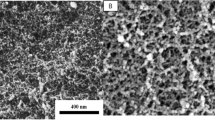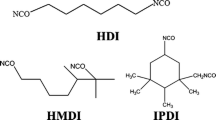Abstract
Silica aerogel was synthesized with water glass precursor and ambient pressure drying method. It was modified with activated carbon (AC), and the silica aerogel-AC nanocomposites were synthesized. The properties of samples were characterized by measurement of bulk density and hydrophobicity, scanning electron microscopy analyze, N2 adsorption–desorption BET surface analyzer, BJH analysis and FTIR spectroscopy. Then the synthesized materials were used as the adsorbent of phenol, and their potential in adsorption from aqueous solution was studied. Mass adsorption and continuous operation with reflux were carried out for evaluation of adsorbents. The effect of addition of AC, the presence of sun light, contact time and initial phenol concentration on the phenol adsorption of silica aerogel were investigated. The presence of sun light played obvious effects on phenol removal. The adsorption process reached equilibrium in 6 h of contact. Increase in the initial phenol concentration could effectively increase the phenol adsorption capacity. The maximum phenol adsorption capacity was obtained as 8.05 (g g−1) for 60 vol% initial phenol concentration in mass adsorption, and 12.87 (mg g−1) for 200 mg l−1 initial phenol concentration in continuous adsorption process at 30 ± 2 °C. The results of mass adsorption method on silica aerogel-AC nanocomposite showed that the addition of AC to silica aerogel had improved the silica aerogel and 0.5 wt% silica aerogel-AC nanocomposite had a higher adsorption capacity compared to pure silica aerogel. It was found that synthesized silica aerogel has an excellent adsorption capacity for concentrated phenol solutions and its performance for adsorption of phenol from dilute solutions is comparable to the literature adsorbents for phenol. The adsorption kinetic and isotherm studies showed that the pseudo-second-order model and Freundlich isotherm were best choices to describe the adsorption behaviors.
Graphical Abstract
In this study, silica aerogel and the silica aerogel-activated carbon nanocomposites were synthesized. Then the synthesized materials were used as the adsorbent of phenol and their potential in adsorption from aqueous solution was studied. It was found that synthesized silica aerogel has an excellent adsorption capacity for concentrated phenol solutions and its performance for adsorption of phenol from dilute solutions is comparable to the literature adsorbents for phenol.














Similar content being viewed by others
References
Busca G, Berardinelli S, Resini C, Arrighi L (2008) Technologies for the removal of phenol from fluid streams: a short review of recent developments. J Hazard Mater 160:265–288
Banat F, Al-Bashir B, Al-Asheh S, Hayajneh O (2000) Adsorption of phenol by bentonite. Environ Pollut 107:391–398
Dabrowski A, Podkościelny P, Hubicki Z, Barczak M (2005) Adsorption of phenolic compounds by activated carbon—a critical review. Chemosphere 58:1049–1070
An F, Gao B (2008) Adsorption of phenol on a novel adsorption material PEI/SiO2. J Hazard Mater 152:1186–1191
An F, Gao B, Feng X (2009) Adsorption mechanism and property of novel composite material PMAA/SiO2 towards phenol. Chem Eng J 153:108–113
Lin K, Pan J, Chen Y, Cheng R, Xu X (2009) Study the adsorption of phenol from aqueous solution on hydroxyapatite nanopowders. J Hazard Mater 161:231–240
El-Safty S (2003) Sorption and diffusion of phenols onto well-defined ordered nanoporous monolithic silicas. J Colloid Interface Sci 260:184–194
Idris A, Saed K (2003) Possible utilization of silica gel sludge for the removal of phenol from aqueous solutions: laboratory studies. Environmentalist 23:329–334
Khalid M, Joly G, Renaud A, Magnoux P (2004) Removal of phenol from water by adsorption using zeolites. Ind Eng Chem Res 43:5275–5280
Gorle BS, Smirnova I, McHugh MA (2009) Adsorption and thermal release of highly volatile compounds in silica aerogels. J Supercrit Fluids 48:85–92
Liu H, Sha W, Cooper AT, Fan M (2009) Preparation and characterization of a novel silica aerogel as adsorbent for toxic organic compounds. Colloids Surf A 347:38–44
Liu G, Yang R, Li M (2010) Liquid adsorption of basic dye using silica aerogels with different textural properties. J Non Cryst Solids 356:250–257
Standeker S, Novak Z, Knez Ž (2007) Adsorption of toxic organic compounds from water with hydrophobic silica aerogels. J Colloid Interface Sci 310:362–368
Bargozin H, Amirkhani L, Moghaddas J, Ahadian M (2010) Synthesis and application of silica aerogel-MWCNT nanocomposites for adsorption of organic pollutants. Sci. Iran 17:122
Bangi UKH, Rao AV, Rao AP (2008) A new route for preparation of sodium-silicate-based hydrophobic silica aerogels via ambient-pressure drying. Sci Technol Adv Mater 9:035006
Shewale PM, Rao AV, Rao AP (2008) Effect of different trimethyl silylating agents on the hydrophobic and physical properties of silica aerogels. Appl Surf Sci 254:6902–6907
Fernandez E, Hugi-Cleary D, López-Ramón MV, Stoeckli F (2003) Adsorption of phenol from dilute and concentrated aqueous solutions by activated carbons. Langmuir 19:9719–9723
Roig B, Gonzalez C, Thomas O (2003) Monitoring of phenol photodegradation by ultraviolet spectroscopy. Spectrochim Acta Part A Mol Biomol Spectrosc 59:303–307
Caimei FAN, Yangin M, Gang HX, Ping SY, Jun LX (2003) Adsorption and photocatalytic degradation of phenol over TiO2/ACF. Trans Nonferrous Met Soc China 13:452–456
García A, Matos J (2010) Photocatalytic activity of TiO2 on activated carbon under visible light in the photodegradation of phenol. Open Mater Sci J 4:2–4
Ioannou Z, Simitzis J (2009) Adsorption kinetics of phenol and 3-nitrophenol from aqueous solutions on conventional and novel carbons. J Hazard Mater 171:954–964
Stavropoulos G, Samaras P, Sakellaropoulos G (2008) Effect of activated carbons modification on porosity, surface structure and phenol adsorption. J Hazard Mater 151:414–421
Yildiz A, Gür A, Ceylan H (2006) Adsorption of aniline, phenol, and chlorophenols on pure and modified bentonite. Russ J Phys Chem 80:S172–S176
Author information
Authors and Affiliations
Corresponding author
Rights and permissions
About this article
Cite this article
Firoozmandan, M., Moghaddas, J. & Yasrebi, N. Performance of water glass-based silica aerogel for adsorption of phenol from aqueous solution. J Sol-Gel Sci Technol 79, 67–75 (2016). https://doi.org/10.1007/s10971-016-4007-2
Received:
Accepted:
Published:
Issue Date:
DOI: https://doi.org/10.1007/s10971-016-4007-2




